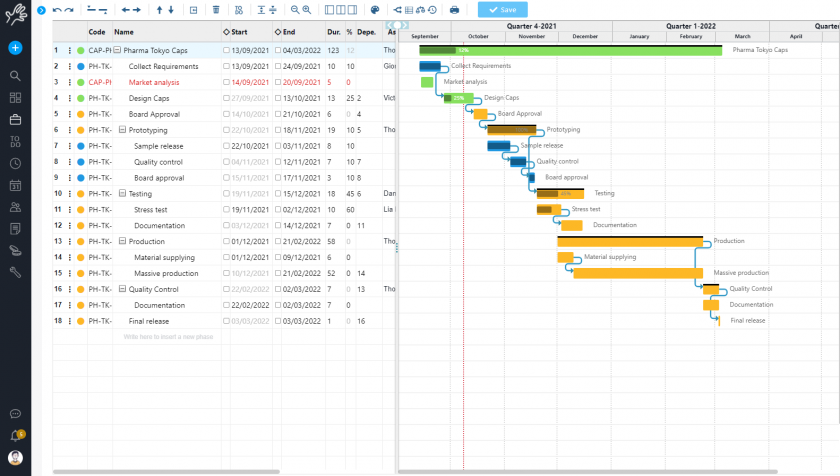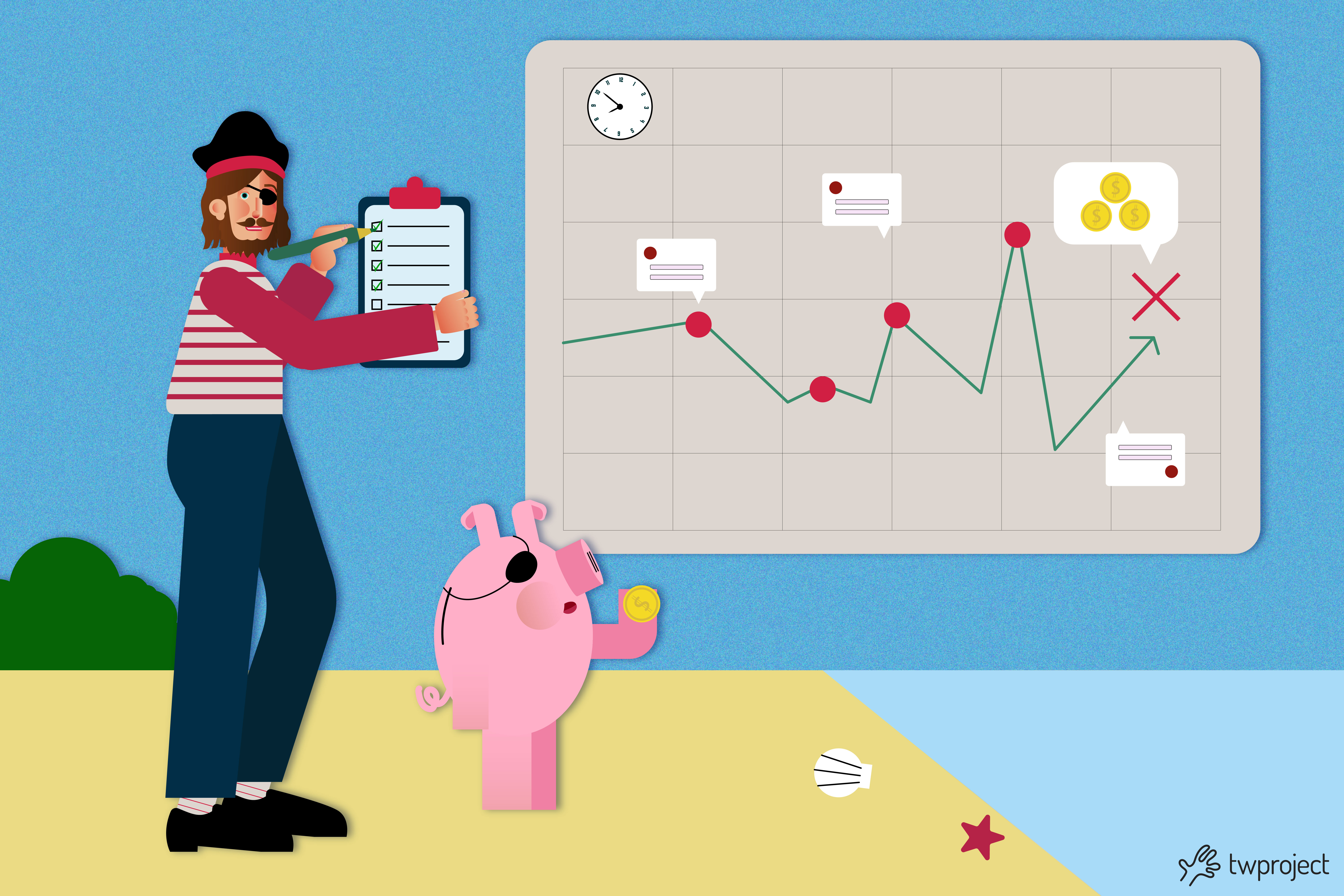A strategic project plan is more than just an operational document: it is a guiding light for the team, a map that leads from the initial idea to the final delivery. A good plan helps manage resources, time, and priorities effectively, reducing risks and maximizing a project’s success.
In this guide, you will learn how to build a comprehensive strategic plan, which tools to use, and which elements are essential, and you will see real examples that can be applied in your company.
INDICE
- 8 Steps to develop a strategic project plan
- 1. Define your project goals
- 2. Determine the scope of your project
- 3. Breaking down work in planning stages
- 4. Assigning roles and team members
- 5. Using a project management tool
- 6. Estimating time, costs, and resources
- 7. Monitoring and adapting: your plan can be dynamic
- 8. Finalizing the project and analyzing the end results
8 Steps to develop a strategic project plan
1. Define your project goals
Defining project objectives means answering these questions clearly:
- What do we want to achieve exactly?
- Why is this project important for the company?
- How will we measure the success of a project?
- When will the final results be achieved?
The SMART (Specific, Measurable, Attainable, Relevant, Time-bound) methodology is a solid starting point.
A clearly defined goal gives direction, motivates team members, and makes work measurable. Without defined goals, even the best management plan is doomed to fail.
For example:
Generic goal: “Improve the website.”
This does not state how much improvement is desired, in what time frame, or how. Thus, team members will not have a clear direction.
SMART goal: “By September 30, increase website conversions by 25% through UX optimization and reduced load times.”
-Specific: improve UX and speed
-Measurable: +25% conversions
-Attainable: with technical measures and tests
–Relevant: improve sales
–Time-bound: by September 30
- Link objectives to the project plan
Goals should be directly reflected in the structure of the project plan. This means:
- Break down objectives in every specific task (e.g., “A/B checkout testing,” “redesign product page”)
- Assign clear responsibilities to team members
- Define metrics to monitor
- Insert temporal milestones in the project life cycle
- Common mistakes to avoid
- Unclear or qualitative objectives
E.g.: “Be more visible on the market.” → Better: “Get 30 press mentions in 3 months.”
2. Too many non-priority objectives
When everything is important, nothing really is.
3. Objectives imposed from above without consensus
A capable project manager involves stakeholders and teams in defining objectives to ensure feasibility.
2. Determine the scope of your project: define what is included (and what is not)
Accurately defining a project‘s scope is vital to avoid ambiguity, contain costs, and prevent the dreaded “scope creep” (the uncontrolled increase in requirements during the project).
The scope of the project describes:
- What the project should consist of (products, features, services, results)
- What can be excluded or postponed
- Who is involved
- What limitations, assumptions, and restrictions should be considered
It is basically the project’s perimeter: everything that falls within or outside its boundaries.
Why is it crucial to define the scope?
- To prevent conflicts between stakeholders
- It shields the team from unexpected workloads
- It helps the project manager manage time and budgets
- It provides a basis for quality control
- It is the starting point for creating the management plan.
What does a solid scope statement include?
A comprehensive scope statement must be documented, approved, and shared. It must include:
| Item | Description |
| Descrizione del progetto | What is the project about, and why was it launched |
| Project description | End results to achieve |
| Deliverable | What will be delivered in concrete terms |
| Requirements | Functional and non-functional |
| Main activities | Broad list of macro-activities |
| Exclusions | What is not included |
| Assumptions | Assumptions accepted at the initial stage |
| Constraints | Technical, regulatory, time, or financial constraints |
For example:
Included (project scope)
- Mobile-friendly platform development
- Payment gateway integration
- Order management and tracking system
- Basic reporting (sales, users, conversions)
- Translation into 2 languages
Excluded (out of scope)
- Integration with company CRM
- Advanced loyalty system
- Native app for iOS/Android
- Separate B2B platform
When an IT agency takes on this project without documenting exclusions, it will soon be “chasing” extra requests that were not included in the initial budget.
- Scope Creep: the silent enemy
By “scope creep,” we mean the gradual, uncontrolled expansion of the project scope due to unofficial requests, misunderstandings, or a lack of clear boundaries.
Example: The customer asks to “just add one extra module,” then asks for two more… and the project plan spirals out of control. The team is overloaded, the project is delayed, and costs increase.
How to avoid it:
- Document and get approval for every change
- Devise a change request process
- Keep the scope statement up to date
- Useful tools for managing the scope
- WBS (Work Breakdown Structure) → breaks down work into manageable parts
- Scope Statement → official document that defines the scope
- Stakeholder matrix → outlies roles, responsibilities, and expectations
Twproject → it helps link goals, deliverables, and tasks to the approved scope
3. Breaking down work in planning stages
Having defined the project‘s scope, it is time to organize work into manageable steps. This process is known as the Work Breakdown Structure (WBS) and allows you to identify every task necessary to achieve the final results.
The main planning stages are:
- Initiation – goal setting, stakeholder analysis
- Planning – project plan drafting, resource allocation
- Execution – execution of operational activities
- Control – progress and quality monitoring
- Closeout – validation of final results and documentation
Example – Product Launch Project:
- Initiation: Market analysis, SWOT
- Planning: Gantt + budget + team
- Execution: Prototype, marketing campaign
- Control: Weekly KPIs
- Closeout: debrief, retrospective, final report
Splitting the project life cycle into phases allows for better forecasting of resources and risks.
4. Assigning roles and team members
Strategic project planning cannot overlook the composition and effective management of the team. Even the best plan can compromise a project’s success if roles are unclear or people are not suited to their assigned tasks.
Assigning the right team members with well-defined roles is crucial to achieving objectives and delivering final results on time and budget.
Every project requires a mix of technical, managerial, and interpersonal skills. The project manager must:
- Identify the key skills required
- Map resource availability
- Assign roles consistent with the scope of the project
- Facilitate collaboration and communication
5. Using a project management tool
A management tool is the cornerstone of agile and controlled project planning. It helps to centralize information, coordinate team members, monitor progress, and facilitate ongoing communication.
Why you need a dedicated tool (and why Twproject makes the difference)
According to a recent analysis, without a proper management tool, you risk encountering:
❌ To-do lists scattered across emails and Excel sheets: Over time, every team starts to pile up outdated Excel files, emails with “forgotten” tasks, and chat messages that are difficult to track
Twproject centralizes everything: tasks, deadlines, comments, documents, and notes are always accessible in a single shared dashboard that can be updated in real-time.
❌ Lack of visibility regarding activity status
Without clarity, project managers cannot determine whether a phase is delayed, who is slowing things down, or whether the project can still be delivered on time.
With Twproject, each activity has a visual indicator of its status, deadline, and the person responsible. Gantt and Kanban views provide insight into the entire project lifecycle in just a few clicks. Dashboards highlight critical issues and overall performance.
❌ Poor coordination between assets
Without a shared system, team members can duplicate efforts, forget tasks, or disagree about who should do what.
Twproject integrates project planning features with accurate roles, workloads, and resource availability assignment. You can also view scheduling conflicts and rebalance work.
Practical benefits of Twproject for project management
- Dynamic Gantt: Every adjustment updates times and dependencies in real time
- Kanban board For agile and visual task management
- Integrated Time tracking to track actual effort and analyze productivity
- Centralized document management, with versioning and attachments
- Smart notifications via email, mobile, and dashboard
- Customizable reports and KPIs: To monitor all activities and the whole project plan

6. Estimating time, costs, and resources
One of the most challenging elements of project management is the realistic estimation of three key elements:
- Schedule: How long will each activity last?
Estimating times means predicting how long each activity will take within the different planning phases. The most commonly used techniques include:
- Expert estimate: Check with experienced professionals or use historical data
- Analogy: Compare with similar projects that have already been completed
- Parametric estimate: calculation based on quantity (e.g., 2 days for 10 pages)
- PERT (Program Evaluation and Review Technique)
Task: Mobile UI design
- Optimistic: 2 days
- Probable: 4 days
- Pessimistic: 7 days
- → Estimated time = 4.2 days
With Twproject, you can assign tasks with expected durations and get your views in the Gantt chart automatically updated.
- Costs: How much will it cost to complete the project
Calculate:
- Hours x asset cost
- Licenses, suppliers, tools
- A margin for unforeseen circumstances (10–20%)
Twproject makes it possible to compare estimated and actual costs in real-time.
- Resources: What skills and people need to be involved
Assign team members to tasks based on:
- Skills
- Availability
- Workload
Twproject flags overloads so you can monitor and balance workloads across departments.
Errors at these stages jeopardize the entire project plan and can lead to delays, budget overruns, and team member burnout.
7. Monitoring and adapting: your plan can be dynamic
A plan is not static. As the project progresses, the data collected should drive adjustments.
For example, a new technical limitation may emerge during development. The project manager will call a meeting and update the management plan, postponing one milestone and bringing forward another.
Flexibility is a critical quality in dynamic settings.
8. Finalizing the project and analyzing the end results
La fase di chiusura permette di:
The closeout phase allows you to:
- Verify whether project goals have been achieved
- Evaluate the quality of the final results
- Measure KPIs
- Gather feedback from stakeholders and teams
Creating a final project review document helps the company learn, improve, and replicate the success in future projects.
The project manager gains complete control over key variables by developing a detailed, well-structured, and shared plan. Every project can become a success story if managed with:
- clear project planning,
- adequate tools for collaboration and control,
- full awareness of priorities and unexpected events.
A strategic project plan turns a good idea into a solid result. It’s not just a file to be shelved but a dynamic guide that helps you achieve your goals step by step.




